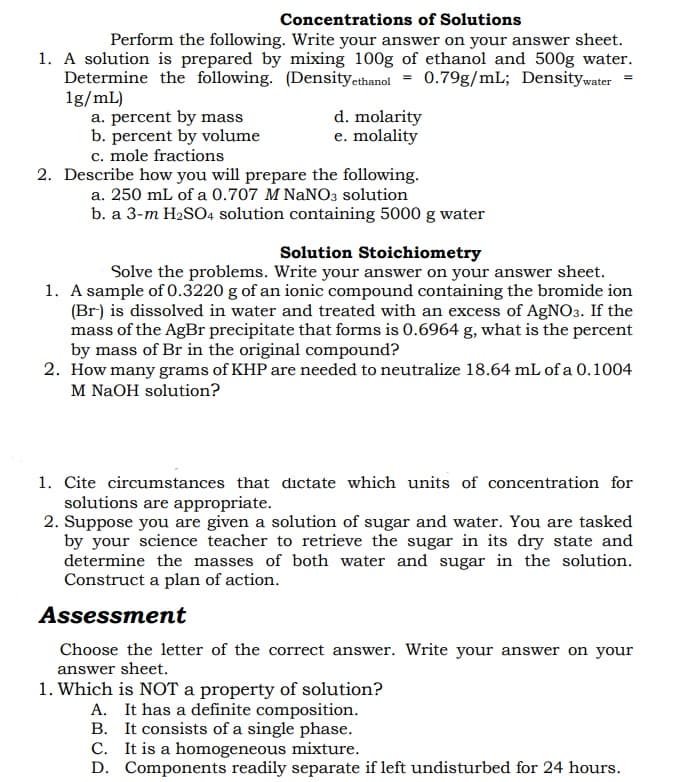1. A solution is prepared by mixing 100g of ethanol and 500g water. Determine the following. (Densityethanol = 0.79g/mL; Densitywater 1g/mL) a. percent by mass b. percent by volume c. mole fractions d. molarity e. molality
1. A solution is prepared by mixing 100g of ethanol and 500g water. Determine the following. (Densityethanol = 0.79g/mL; Densitywater 1g/mL) a. percent by mass b. percent by volume c. mole fractions d. molarity e. molality
Chemistry: Principles and Reactions
8th Edition
ISBN:9781305079373
Author:William L. Masterton, Cecile N. Hurley
Publisher:William L. Masterton, Cecile N. Hurley
Chapter10: Solutions
Section: Chapter Questions
Problem 66QAP: The Henry's law constant for the solubility of radon in water at is 9.57106 M/mm Hg. Radon is...
Related questions
Question

Transcribed Image Text:Concentrations of Solutions
Perform the following. Write your answer on your answer sheet.
1. A solution is prepared by mixing 100g of ethanol and 500g water.
Determine the following. (Densityethanol = 0.79g/mL; Densitywater =
1g/mL)
a. percent by mass
b. percent by volume
c. mole fractions
d. molarity
e. molality
2. Describe how you will prepare the following.
a. 250 mL of a 0.707 M NANO3 solution
b. a 3-m H2SO4 solution containing 5000 g water
Solution Stoichiometry
Solve the problems. Write your answer on your answer sheet.
1. A sample of 0.3220 g of an ionic compound containing the bromide ion
(Br) is dissolved in water and treated with an excess of AgNO3. If the
mass of the AgBr precipitate that forms is 0.6964 g, what is the percent
by mass of Br in the original compound?
2. How many grams of KHP are needed to neutralize 18.64 mL of a 0.1004
M NaOH solution?
1. Cite circumstances that dictate which units of concentration for
solutions are appropriate.
2. Suppose you are given a solution of sugar and water. You are tasked
by your science teacher to retrieve the sugar in its dry state and
determine the masses of both water and sugar in the solution.
Construct a plan of action.
Assessment
Choose the letter of the correct answer. Write your answer on your
answer sheet.
1. Which is NOT a property of solution?
A. It has a definite composition.
B. It consists of a single phase.
C. It is a homogeneous mixture.
D. Components readily separate if left undisturbed for 24 hours.
Expert Solution
This question has been solved!
Explore an expertly crafted, step-by-step solution for a thorough understanding of key concepts.
Step by step
Solved in 6 steps

Knowledge Booster
Learn more about
Need a deep-dive on the concept behind this application? Look no further. Learn more about this topic, chemistry and related others by exploring similar questions and additional content below.Recommended textbooks for you

Chemistry: Principles and Reactions
Chemistry
ISBN:
9781305079373
Author:
William L. Masterton, Cecile N. Hurley
Publisher:
Cengage Learning

Chemistry
Chemistry
ISBN:
9781305957404
Author:
Steven S. Zumdahl, Susan A. Zumdahl, Donald J. DeCoste
Publisher:
Cengage Learning

Chemistry: An Atoms First Approach
Chemistry
ISBN:
9781305079243
Author:
Steven S. Zumdahl, Susan A. Zumdahl
Publisher:
Cengage Learning

Chemistry: Principles and Reactions
Chemistry
ISBN:
9781305079373
Author:
William L. Masterton, Cecile N. Hurley
Publisher:
Cengage Learning

Chemistry
Chemistry
ISBN:
9781305957404
Author:
Steven S. Zumdahl, Susan A. Zumdahl, Donald J. DeCoste
Publisher:
Cengage Learning

Chemistry: An Atoms First Approach
Chemistry
ISBN:
9781305079243
Author:
Steven S. Zumdahl, Susan A. Zumdahl
Publisher:
Cengage Learning


Chemistry & Chemical Reactivity
Chemistry
ISBN:
9781337399074
Author:
John C. Kotz, Paul M. Treichel, John Townsend, David Treichel
Publisher:
Cengage Learning

Chemistry & Chemical Reactivity
Chemistry
ISBN:
9781133949640
Author:
John C. Kotz, Paul M. Treichel, John Townsend, David Treichel
Publisher:
Cengage Learning